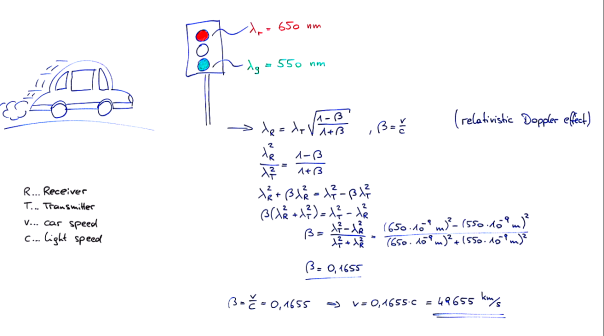How Fast Would You Have to Approach a Red Traffic Light in Order to See it as Green? (Whiteboard Sketch #2)
Werner Heisenberg – driving in his car way too fast – got stopped by a police officer.
Police officer: “Good man, do you know how fast you were actually driving?”
Heisenberg: “No, I don’t, as it is more important to me to know ‘where’ I am.”
In addition to this more or less known physicist’s joke, which aims at Heisenberg’s Uncertainty Principle, I will offer another “physical excuse” for violating the Traffic Code – one for which you probably won’t have a policeman’s ear either.
Surely all of you know this phenomenon by which the siren of a police car sounds much higher-pitched when the car is approaching you, but much lower-pitched when it is moving away. This effect is called “Doppler effect”.
In case of a past-flying police car we have to deal with the acoustic Doppler effect as it is sound waves getting squeezed in the direction of movement and stretched against the direction of movement, resulting in the frequency/wavelength of the received sound being altered after leaving the source with a particular frequency/wavelength. At it, higher frequencies (i.e., smaller wavelengths) result in higher-pitched tones in our ears.
This effect, however, doesn’t only exist for sound waves, but also for light. Speaking in terms of the electromagnetic spectrum’s visible part, low-frequency electromagnetic oscillations correspond to red light whereas high-frequency oscillations are associated with blue light. (The wavelengths are inversely proportional. That is, red light has big wavelengths and blue light short ones.)
All forms of relative motion between light transmitter and receiver result in a Doppler shift of the frequency/wavelength:
If either the transmitter or the receiver (or both, it doesn’t really matter) approaches the other, the light waves get “squeezed together” and appear to be “more blue” than they were when having been sent earlier. In the case of respectively diverging transmitters and receivers, the waves arrive “widened” and “redder”.

The electromagnetic spectrum.
The human-visible part of wavelengths between 400 and 700 nanometers is emphasized.
(Credit: Horst Frank, Phrood, Anony. Via Wikimedia Commons)
(By the way, it is this very Doppler effect which strongly indicates the expansion of the universe: It was observed that the light of almost all distant stars and galaxies arrived on earth in a “stretched” way and therefore was shifted towards the red part of the electromagnetic spectrum. Thus, it can be concluded that all these objects in the universe drift apart from each other, or, more generally, that the universe itself expands. This is what scientists mean when speaking of the “cosmological redshift”.)
If you, however, head towards a light source, you will receive its light with a higher frequency. Depending on your speed, red light therefore will eventually turn yellow, then green, then blue, then purple,…
So, why not ask the following question:
How fast would you have to approach a red traffic light in order to see it as green?

Little spoiler: The above-sketched car will have great difficulty in speeding that fast that the red light appears to be green.
A brief calculation which makes use of the formula for the relativistic (longitudinal) Doppler effect shows that you would have to put your foot down until you reach insane 49.655 kilometers per second (30.855 miles per second). At such speeds, indeed, a red light would appear to be green!
(If you could manage to convince the police officer that you didn’t run the red light since it actually was green from your perspective, you would probably have to expect a hefty speeding fine. And I would doubt whether the officer is willing to discuss the Heisenberg Uncertainty Principle then. 😉 )
Addendum: If you also want to know why, eventually, you won’t be needing your rear-view mirror anymore when driving at ultra-high speeds (since you will be able to see things actually being behind you without looking into the mirror), read my older post “How to Literally See Around the Corner”.
Posted on May 4, 2014, in Electromagnetism, Fun Fact, Optics, physics, Relativity and tagged Doppler effect, Doppler shift, electromagnetic spectrum, Electromagnetism, Physics, Special relativity, Thought experiment, whiteboard sketch. Bookmark the permalink. 2 Comments.

I confess I had thought thirty miles per second sounded terribly low, but realized I was misreading the thousands separator.
Similar things often happen to me too. 😉
Anyway, my calculated speed is about 17 per cent of the speed of light. From a human perspective, this is enormously fast! (But I know that you know that 😉 )